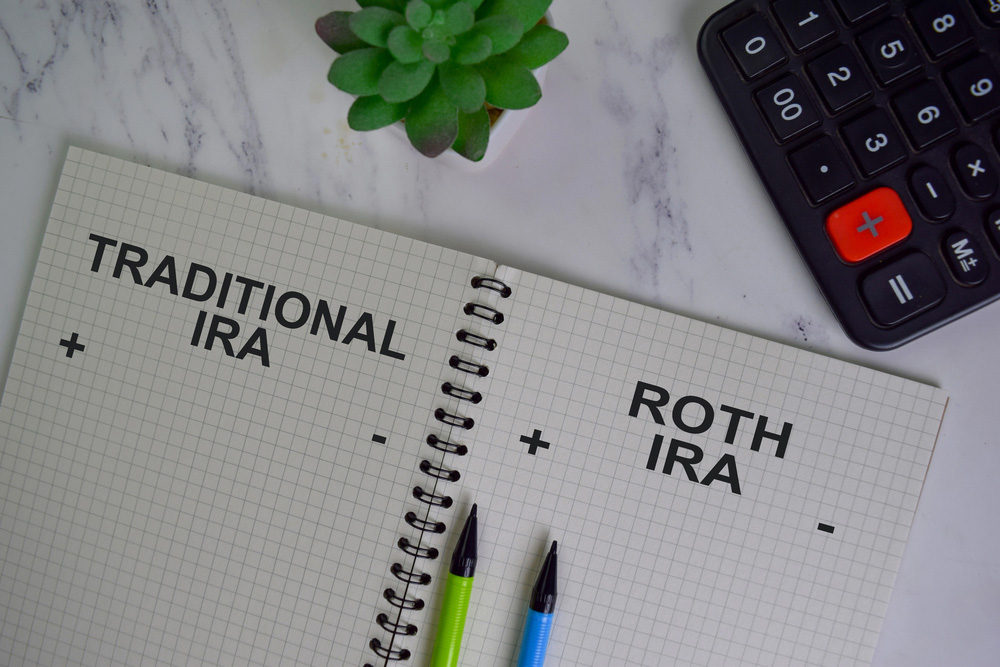When planning for retirement, people tend to wonder: Can you have a traditional and Roth IRA at the same time? The simple answer is yes. In fact, having both types of individual retirement accounts (IRAs) can be a strategic way to maximize your retirement savings.
Each of these accounts offers distinct tax advantages and, depending on your financial goals, combining them could work to your benefit. However, knowing the rules, eligibility criteria, and contribution limits for both accounts is important to avoid potential pitfalls.
Can You Have A Traditional and Roth IRA? Let’s See the Basics of Both
The Traditional IRA
A traditional IRA is a retirement account where contributions may be tax-deductible in the year they are made, depending on your income and whether you have access to an employer-sponsored retirement plan.
Traditional IRA money grows tax-deferred, so you don’t pay taxes on your earnings unless you take them out, usually in retirement.
The main benefit of a traditional IRA is the potential for immediate tax savings. The amount you contribute to the account reduces your taxable income for the year, which could lead to a lower tax bill.
However, once you begin withdrawing from the account, typically after the age of 59½, those distributions are subject to income tax.
It’s important to note that traditional IRAs also come with certain contribution limits. As of 2025, the maximum amount you can contribute to a traditional IRA is $6,500 per year (or $7,500 if you’re 50 or older), though this may change depending on inflation adjustments.
The Roth IRA
A Roth IRA operates differently when it comes to taxes. Roth IRA contributions are done with after-tax dollars, meaning you don’t get a tax deduction when you contribute.
However, the advantage is in the fact that your earnings grow tax-free. During retirement, qualified withdrawals are also tax-free.
Roth IRAs have a few unique benefits. For one, there is no required minimum distribution (RMD) during the account holder’s lifetime. This makes it an attractive option for those who want their retirement savings to continue growing without being forced to start withdrawals at age 72.
Also, because you contribute after-tax dollars, there’s no tax bill when you take distributions. That is provided certain conditions are met, such as reaching the age of 59½ and holding the account for at least five years.
Like traditional IRAs, Roth IRAs also come with contribution limits. In 2025, you can contribute up to $6,500 annually (or $7,500 if over 50). However, eligibility to contribute to a Roth IRA phases out for individuals earning above certain income thresholds.
Can You Have Both a Traditional and Roth IRA?
Now that we’ve covered the basics of each account, you might be wondering, can I have both a traditional and Roth IRA? The answer is yes. You can hold both types of IRAs simultaneously, but there are some important rules to consider.
First, the total amount you contribute across both IRAs in a given year cannot exceed the annual contribution limit. For example, in 2025, you can contribute a total of $6,500 (or $7,500 if you’re 50 or older) across both accounts.
You can contribute $3,250 to your traditional IRA and $3,250 to your Roth IRA or allocate the funds differently. Here’s the catch – the total contributions to both accounts combined cannot exceed the annual limit.
Why Would Someone Want Both Accounts?
There are several reasons why holding both a traditional and Roth IRA could be beneficial. One major advantage is the ability to diversify your tax exposure.
Contributions to a traditional IRA can reduce your taxable income now, while Roth IRA contributions offer the benefit of tax-free withdrawals in retirement.
By having both types of accounts, you essentially give yourself options when it comes time to retire. You can choose to withdraw from the traditional IRA, taking advantage of the tax-deferred growth, or you can pull from the Roth IRA for tax-free income.
This can be especially helpful if you’re concerned about being in a higher tax bracket in retirement.
Another reason to consider holding both types of accounts is the flexibility they provide in terms of self-directed IRAs. A self-directed IRA allows you to have more control over your investments, including the ability to invest in alternative assets like real estate or precious metals.
With both a traditional and Roth IRA, you can diversify your investments in different ways, potentially maximizing your portfolio’s growth over time.
Eligibility Rules for Contributing to Both Accounts
It’s important to note that there are certain eligibility criteria that may limit your ability to contribute to both a traditional and Roth IRA.
For a traditional IRA, you can contribute regardless of your income, but your eligibility for tax deductions may be affected by your income and whether you’re covered by an employer’s retirement plan.
If you’re covered by a plan at work, your tax deduction for traditional IRA contributions may phase out based on your modified adjusted gross income (MAGI).
On the other hand, for a Roth IRA, there are income limits that could prevent you from contributing. For single filers, the ability to contribute to a Roth IRA starts phasing out at a MAGI of $140,000 in 2025, and for married couples, the phase-out starts at $218,000.
If you earn above these thresholds, you may not be able to contribute directly to a Roth IRA. However, there is a strategy known as a “backdoor Roth IRA” that allows high earners to contribute indirectly through a traditional IRA.
Tax Considerations
Having both a traditional and Roth IRA can be a useful way to diversify your retirement tax situation, but it’s important to plan ahead for how these withdrawals will impact your taxes in retirement.
With a traditional IRA, withdrawals are taxed as ordinary income, while with a Roth IRA, qualified withdrawals are tax-free.
The tax planning opportunities for retirees with both types of accounts are considerable. Having tax-free income from a Roth IRA can be particularly helpful in managing your overall tax burden during retirement.
In contrast, withdrawals from a traditional IRA may push you into a higher tax bracket, so it’s important to strategize how and when you make withdrawals from each account.
Managing Both Accounts with Professional Assistance
Managing multiple retirement accounts, including both a traditional and Roth IRA, can be complicated. To make sure you are making the most of your retirement savings and complying with the rules, it’s helpful to work with a financial advisor or trust company.
Nevada Trust Company® offers custody and escrow services, helping individuals manage their assets with precision and care. We assist with the administration of trusts and IRAs, making certain that your retirement plan is optimized for your financial goals.
If you’re looking for professional advice and support in managing your traditional and Roth IRAs, we’re here to help. Our team is committed to guiding clients through the complexities of retirement planning, offering personalized solutions for each individual’s needs.
Our Expertise in Retirement Planning
Nevada Trust Company® sees retirement planning as a long-term process that requires careful consideration of your goals and financial circumstances. Managing both a traditional and Roth IRA can be a smart strategy for those looking to diversify their retirement savings and reduce their tax burden over time.
We are here to assist with all aspects of wealth management, including the administration of IRAs, asset protection, and trust services.
If you have any questions about aNevada asset protection trust or need assistance managing your retirement accounts, feel free to contact us. We are always available to offer guidance and expert solutions customized to your unique situation.





